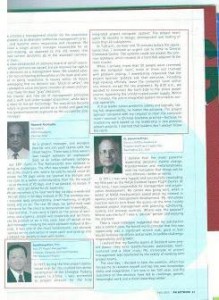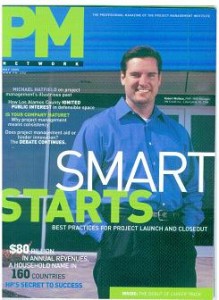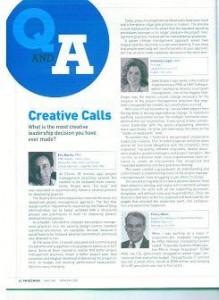PMI PM Network (Sept 2005): Creative Decision In Handling Project Crisis
Published by SK Khor PMP, PMI PM Network Magazine , Sept 2005
Shorter version of this paper will be published in the Sept 2005 Edition of PMI’s PM Network monthly Magazine.
What was the most creative leadership decision you have ever made?
SK would say it was during the first airport operational trial in 1999 for the multi billion Dollars construction of the Shanghai Pudong Airport in China. SK was the Master System Integrator’s System Architect subsequently promoted to Project Director for the multi million Dollars, fully integrated airport computer system.
The Chinese Aviation Authority has announced that three major operation trials would be organized before the final airport opening dates will be announced. The project team SK was managing comprised of more than 100 individuals from more than twenty nationalities. The project team had spent 18 months in design, development and a series of testing involving more then forty sub-systems. The entire team was motivated by the desire to make the First Fully Integrated Airport System in China a reality!!
Two days before the trial, as a leader, SK motivated the entire team with his usual inspiration speech, the team morale was extremely high and everyone has committed to execute their respective roles and responsibilities according to the 24 hours details test plan. A successful trial of the fully integrated airport system to support 8000 people, simulating as passengers, taxi drivers, airport and airlines staffs, proper handling of real aircrafts and thousands of baggaeswould immediately grant the customer project sponsor a trump card to convince the City Government of their wise decision on the technology investment. Afailure, however, would cause major embarrassment to customer project sponsor, demoralize the project team and provide golden opportunity to the project opponent to reject the integrated airport system.
Finally, the D-Day arrived. SK arrived to the new airport at 5.00am, 4 hours before the trial. SK and his senior Project Management members went over room-by-room, system by system, going through all the check-lists and procedures with all the team leaders. Everything was in proper order.
7.45am, SK received a call from the walkie-talkie, “SK , SK , urgent !! Please come to Central Command Center – we have an emergency situation!” Without further delay, SK jumped into the project’s car and the project’s driver managed to bring SK from one end of the new airport to the Command Center in half of the usual time.
At the Command Center’s computer room, SK saw so many people surrounded the two consoles that controls the most critical core systems of the Airport. The two engineers were sitting in front of the terminals with their hand shaking and face sweating. After few minutes, the situation was not improved. No one seems to know exact what had happened and what was the next cause of action. At the point in time, there are more than 50 people crammed into the computer room; and most of them have nothing to do with problem solving. Some of them have even started to speculate what had happened.
8.05 am SK’s counterpart, the key customer’s Project Sponsor heard the news and arrived. He checked with SK on the status and what was the action plan. As the situation is so chaotic, SK first priority was to request the Project Sponsor to politely request everyone, including the high ranking officials (Respect to protocol and hierachy is very important in China) to leave the computer room within one minute except the two engineers. Project sponsor announced only SK and his tow engineers were allowed in the computer room. SK promised to give status update every 15 minutes to the Project Sponsor. The Project Sponsor became the single point of contact to the outside world.
By 8.15am, the Commander In Charge for the operational trial made announcement the trial will start at 9.00am without the fully integrated airport system. The trial will simulate airport in the manual operation mode, which was exactly what the Project Opponent was looking forward. The announcement demoralized the entire project team. The chances of their dream of a fully integrated airport could be realized begin to fad.
Mean while, the two engineers still felt very nervous. Putting SK’s own career on the ‘chopping block’, SK told them that SK and his organization, the Master System Integrator would take full responsibility to their decision and any consequences of their actions.
The situation was that the systems could not assess the common database which was resided on a hard disk located adjacent to the main cluster. One of the engineer suspected it may due to intermittent supply of power from the Uninterrupted Power Supply (UPS) source. But the chances of this to happen was very slimed, none of us has seen this in our life time.
By 8.30am, 30 minutes before the begin of the trial, SK and the two engineers decided to reconnect the hard disk to the direct power source by passed the UPS, as this was the only best thing they could do at that point in time. Within 10 minutes, the entire integrated system back to normal operation.
By 8.45am, SK reported the good news to the Project Sponsor, who has been playing the role of “door guard”, stopping unwanted people enter the computer room. Without further delay, the Project Sponsor call the Command In Charge for the trial and desperately asking to included the Integrated System as part of the trial. The request was granted.
9.00am, The First operational trial was executed in a fully automated manner using state of the arts fully integrated airport technologies without major glitches. The Project Sponsor, project team and SK felt the excitement with the success of first trial given the airport operators have started to appreciated the system, and indirectly rule out all the negative statements and rumors from the project opponent.
How has it shaped your career?
The above story helped me to realize the how importance and speedy a project manager can put a complete chaotic and panic project situation into a more controllable situation using his instinct creativity. In this case, SK requested his Project Sponsor to politely request the room to be cleared within one minute. The result may not be ‘that great’ if SK had raised his voice and instruct the crown to leave the room immediately which may cause confrontation and tarnished the ‘Guan Xi’ with other stakeholders.
The first trial with Integrated System had granted the license of conformation the airport will be opened with fully integrated airport system, the first in the Chinese aviation history.
Achieved this critical milestone led SK to realize
- A true leader is the one who helped to assist his 100 plus fully committed project team members to realize their dream. A ‘selfish’ leader would properly never agree to put his career on ‘chopping block’ when dealing with crisis.
- Project leadership was not build over night and must be earned. Later, the Project Sponsor admitted the reason he agreed with SK’s ‘unusual’ request because he trusted of SK’s proven leadership in previous two international airport projects and his willingness to take risks and bear the consequences caused by his team members since the beginning of the project. This was unusual in the Chinese business practice.
- Leader not always goes with the norm. The ‘usual request’ did help him to inspire customer’s Project sponsor because of SK willingness and strong urge to do everything possible so long as there is a hope to help his team members, customer, Project Sponsor to realize their dream. The Project Sponsor was touched and felt ‘obliged’ to respect his leadership and has no reason not to grant his request. Overall, the Project Sponsor is one ultimately responsible for the success or failure of the project.
The evidences of the new airport was opened two weeks ahead of schedule with minimum glitches caused by the Integrated Airport System and ability to lead a multi national , multi-cultural – multi locations project teams in a foreign country has path SK as a rising star in the international Project Management community. His reputation has lead him to be engaged by The MITRE Corporation (www.mitre.org) , the US Government funded think tank for the Inchon International Airport, Korea and the newly open Guangzhou International airport (Aug 2005), Guangzhou, China.
Today, SK has earned himself a reputation as “ International Mega Complex Project Manager” with proven FOUR International airport project track records with minimum of Project of USD 1.5 billion and the Malaysia Government wide Architecture Framework project involving 13 government agencies. His experience and reputation has helped to increase the participants in the ‘Managing Complex Information Technology Project’ program he started three years ago. Last but not least, not to mention the friendship and strong ‘Guan Xi’ he has build with all his friends in China.
References:
- Project Management Institute. (2000) A guide to the project management body of knowledge (PMBOK®) (2000 ed.). Newtown Square, PA: Project Management Institute.
- SoonKheng Khor, Managing Complex IT Projects in China: The Cultural Lesson Learned. PMI European Congress 2003 : Project Management Institute
- SoonKheng Khor, Nan Phin Lee, Managing Complex IT Projects Seminar: Asia ICT Project Management www.asiaictpm.com
- Project Management Institute PM Network Feb 2004. Newton Square PA: Project Management Institute
- Ministry of Education, Taiwan www.edu.tw
- Xin Hanyu Zidian, ISBN 976-9985-92-x , United Publishing House (M) Sdn.Bhd
Note:
- The term “Seller” includes contractor, sub-contractors, vendors and service provider and the term “buyer” includes customers, service receiver and client.




